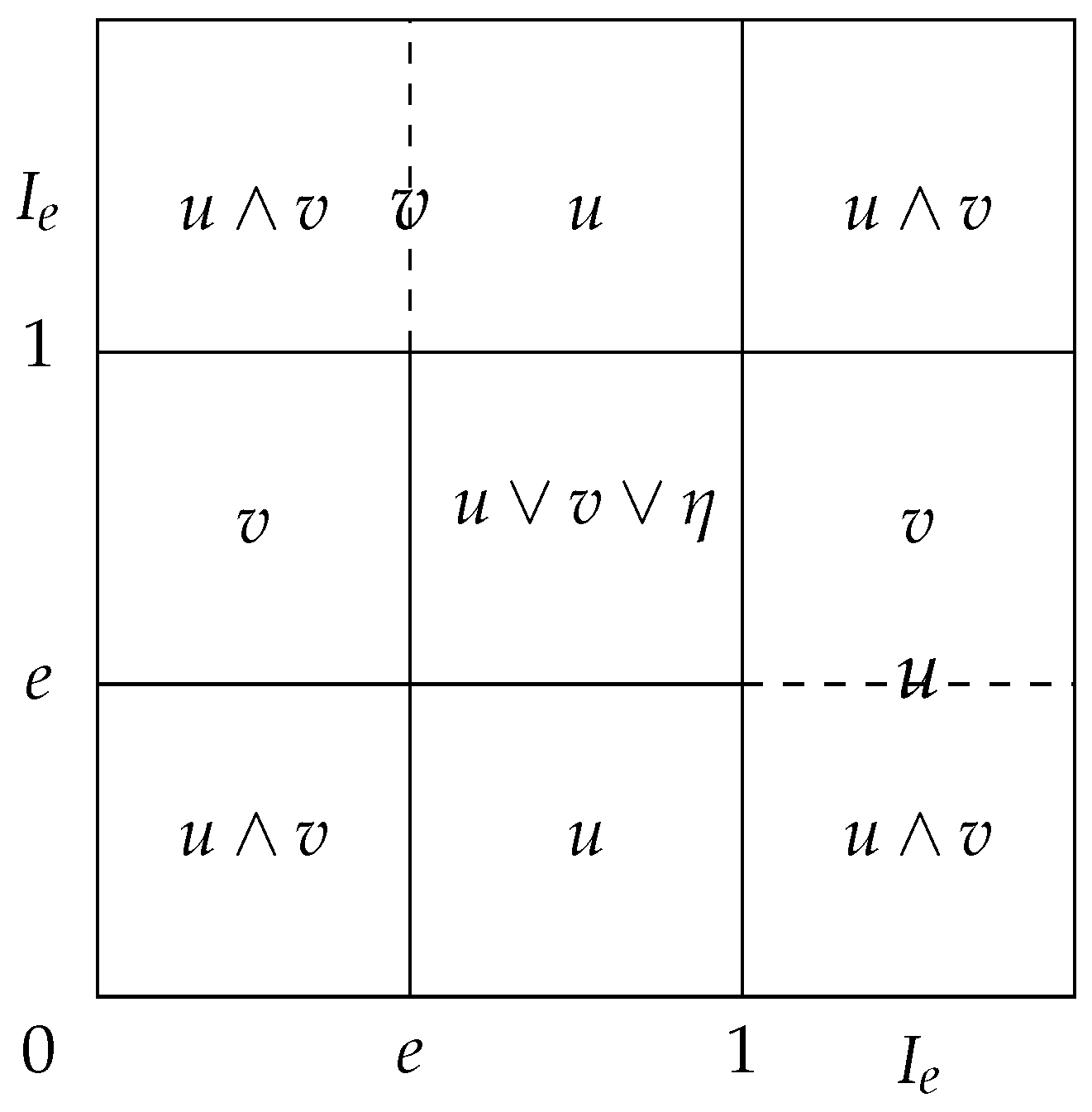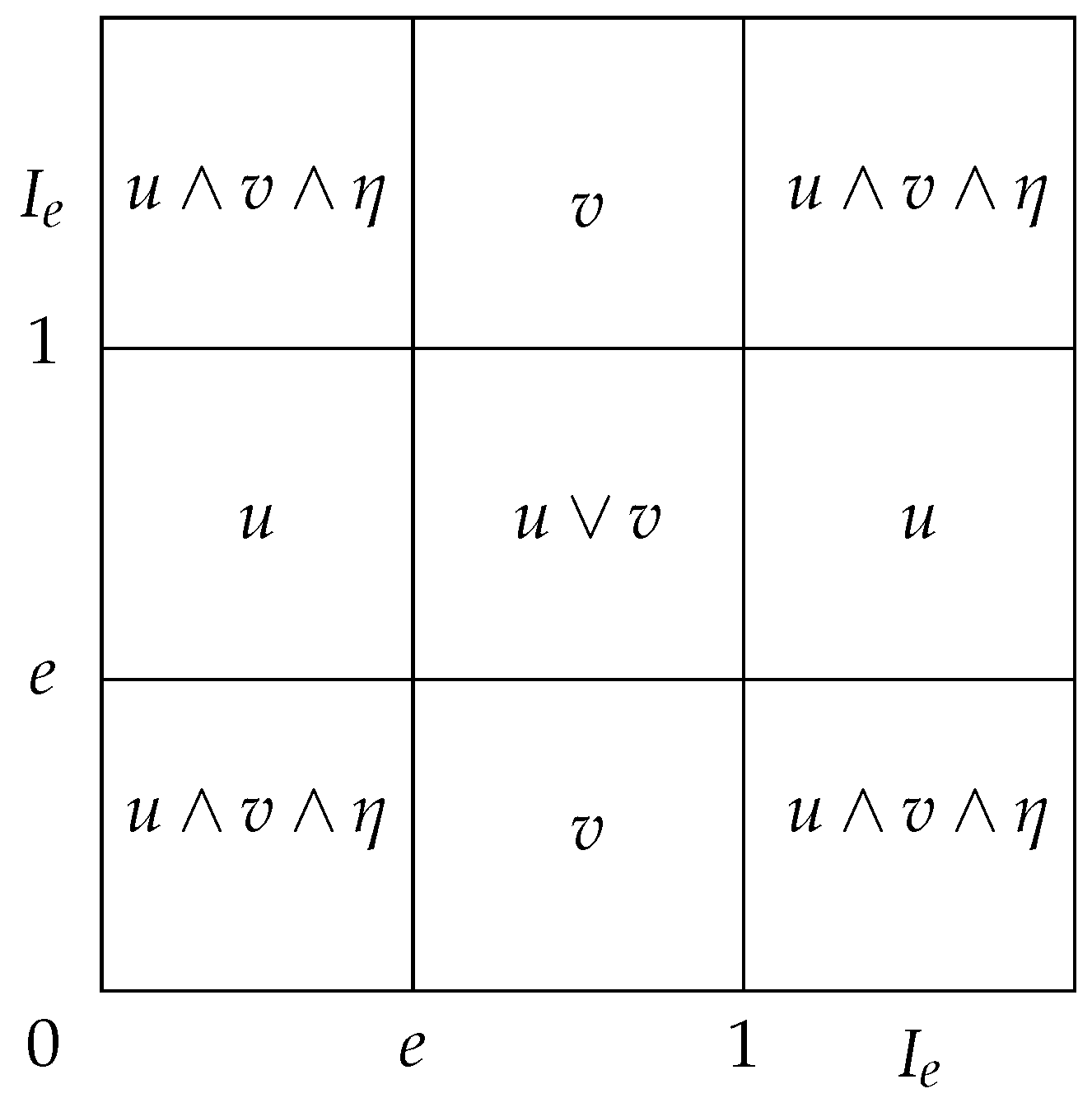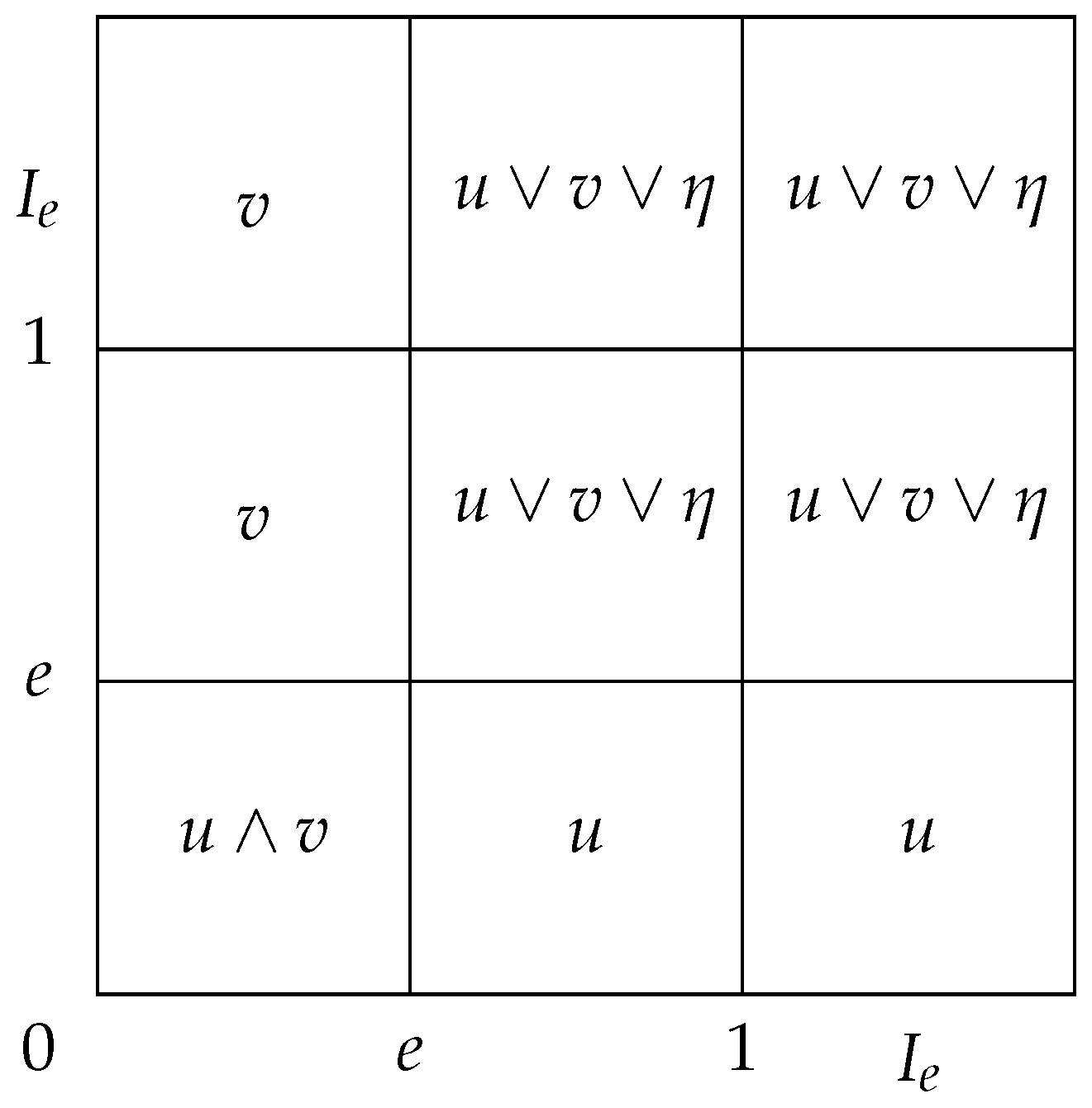3. Element-Based Construction Methods of Uninorms on Bounded Lattices
In this section, Theorems 1, 3 and 5 propose three construction methods for uninorms on a bounded lattice L, determined by an arbitrary fixed point , under which additional constraints are introduced. Our construction methods are compared with some construction methods known from the related literature. Also, the differences between our construction methods and those in the literature are emphasized. Some illustrative examples for our construction methods for uninorms on a bounded lattice are provided.
In the following theorem, a method to produce uninorms by means of an arbitrary element is given.
Theorem 1. Let be a bounded lattice, and . Then the function defined byis a uninorm on L with the neutral element e if and only if for all . Proof. Necessity. Since is monotone, when and . Therefore, it is obtained that .
Sufficiency. (i) Monotonicity: Let us show that for every element with , for all . If u and v are both elements of or or or , is always satisfied for all since . If or , the inequality is satisfied; therefore, they are omitted. The proof is then split into all the remaining possible cases as follows:
- 1.
Let .
- 1.1.
,
- 1.1.1.
If , then
- 1.1.2
If , then
- 1.1.3.
If , then
- 1.2.
,
- 1.2.1.
If , then
- 1.2.2.
If , then
- 1.2.3.
If , then
- 1.3.
,
- 1.3.1.
If
- 1.3.2.
If , then
- 1.3.3.
If , then
- 2.
,
- 2.1.
,
- 2.1.1.
If , then
- 2.1.2.
If , then
- 2.1.3.
If , then
- 3.
,
- 3.1.
,
- 3.1.1.
If , then
- 3.1.2.
If , then
- 3.1.3.
If , then
(ii) Associativity: We demonstrate that for all . If , the equality is satisfied; therefore, they are omitted. Again, the proof is split into all the remaining possible cases by considering the relationships between the elements and e as follows.
- 1.
Let .
- 1.1.
,
1.1.1. If , then
1.1.2. If , then
- 1.2.
,
1.2.1. If , then
1.2.2. If , then
- 2.
.
- 2.1.
,
2.1.1. If , then
2.1.2. If , then
- 2.2.
,
2.2.1. If , then
2.2.2. If , then
It is easy to observe the commutativity of and the fact that e is a neutral element of .
Therefore, is a uninorm on L with the neutral element e. □
The structure of the uninorm
given in the Formula (
1) is summarized in
Figure 1.
In the following example, an illustration of how Theorem 1 is applied is provided.
Example 2. Consider the bounded lattice characterized by the Hasse diagram in Figure 2. If we apply the formula (1) in Theorem 1, the uninorm on is obtained as in Table 1. Remark 1. In general, the uninorm defined in Theorem 1 is different from the uninorms obtained by the construction methods of uninorms in the literature. Considering Example 2, it is easily seen that and , regardless of the choice of the corresponding t-norms on in [5,11,13,15], sincerespectively. Also, it is clear that the lattice satisfies the constraints of Theorem 3.1 in [12] and Theorem 3.1 in [14]. We obtain since regardless of the choice of the t-norm on in [12]. In addition, since regardless of the choice of the t-norm on and the t-conorm on in [14]. Moreover, regardless of the choice of the t-conorm S on in [22], since . Besides all this, since and on any lattice regardless of the choice of the corresponding t-norms on and/or t-conorms on in [5,11,12,13,14,15,22]. Based on the duality principle, another construction method for uninorms on the bounded lattice L is introduced.
Theorem 2. Let be a bounded lattice, and . Then the function defined byis a uninorm on L with the neutral element e if and only if for all . Proof. The proof follows easily from Theorem 1, and therefore, it is omitted. □
The structure of the uninorm
given in the Formula (
2) is summarized in
Figure 3.
With the following theorem, another method to produce a uninorm by means of an arbitrary element is given.
Theorem 3. Let be a bounded lattice, and . Then the function defined byis a uninorm on L with the neutral element e if and only if for all . Proof. Necessity. Since is monotone, when and ; therefore, it is obtained that .
Sufficiency. (i) Monotonicity: Let us show that for every element with , for all . If u and v are both elements of or or or , is always satisfied for all since . If or , the inequality is satisfied; therefore, they are omitted. The proof is then split into all the remaining possible cases as follows:
- 1.
Let .
- 1.1.
,
- 1.1.1.
If , then
- 1.1.2.
If , then
- 1.2.
,
- 1.2.1.
If , then
- 1.2.2.
If , then
- 1.2.3.
If , then
- 1.3.
,
- 1.3.1.
If , then
- 1.3.2.
If , then
- 1.3.3.
If , then
- 2.
,
- 2.1
,
- 2.1.1.
If , then
- 2.1.2.
If , then
- 2.1.3.
If , then
- 3.
,
- 3.1.
,
- 3.1.1.
If , then
- 3.1.2.
If , then
- 3.1.3.
If , then
(ii) Associativity: We demonstrate that for all . If , the equality is satisfied; therefore, they are omitted. Again, the proof is split into all the remaining possible cases by considering the relationships between the elements and e as follows.
- 1.
Let .
- 1.1.
,
1.1.1. If , then
1.1.2. If , then
- 1.2.
,
1.2.1. If , then
1.2.2. If , then
- 2.
.
- 2.1.
,
2.1.1. If , then
2.1.2. If , then
- 2.2.
,
2.2.1. If , then
2.2.2. If , then
It is easy to observe the commutativity of and the fact that e is a neutral element of .
Therefore, is a uninorm on L with the neutral element e. □
The structure of the uninorm
given in the Formula (
3) is summarized in
Figure 4.
In the following example, a uninorm on the bounded lattice with the element is constructed by means of Theorem 3.
Example 3. Consider the bounded lattice characterized by the Hasse diagram in Figure 5. If we apply the formula (3) in Theorem 3, the uninorm on is obtained as in Table 2. Remark 2. It is worth noting that the uninorm is not equal, up to our best knowledge, to the uninorms obtained by the construction methods of uninorms in the literature. Considering Example 3, it is easily seen that and regardless of the choice of the corresponding t-norms on in [5,11,13,15], sincerespectively. Also, it is clear that the lattice satisfies the constraints of Theorem 3.1 in [12] and Theorem 3.1 in [14]. We obtain since regardless of the choice of the t-norm on in [12]. In addition, since regardless of the choice of the t-norm on and t-conorm on in [14]. Moreover, regardless of the choice of the t-conorm on in [22], since . Furthermore, since and on any lattice regardless of the choice of the corresponding t-norms on and/or t-conorms on in [5,11,12,13,14,15,22]. Another construction method is introduced in Theorem 4 without proof, as it is dual to Theorem 3.
Theorem 4. Let be a bounded lattice, and . Then the function defined byis a uninorm on L with the neutral element e if and only if for all , . The structure of the uninorm
given in the Formula (
4) is summarized in
Figure 6.
In the following theorem, a method to produce uninorm by means of a fixed element is given.
Theorem 5. Let be a bounded lattice, and . Then the function defined byis a uninorm on L with the neutral element e. Proof. (i) Monotonicity: Let us show that for every element with , for all . If u and v are both elements of or or or , is always satisfied for all since . If or , the inequality is satisfied; therefore, they are omitted. The proof is then split into all the remaining possible cases as follows.
- 1.
Let .
- 1.1.
,
- 1.1.1.
If , then
- 1.1.2.
If , then
- 1.2.
,
- 1.2.1.
If , then
- 1.2.2.
If , then
- 1.2.3.
If , then
- 1.3.
,
- 1.3.1.
If , then
- 1.3.2.
If , then
- 2.
,
- 2.1.
,
- 2.1.1.
If , then
- 2.1.2.
If , then
- 2.1.3.
If , then
- 3.
,
- 3.1.
,
- 3.1.1.
If , then
- 3.1.2.
If , then
- 3.1.3.
If , then
(ii) Associativity: We demonstrate that for all . If , the equality is satisfied; therefore, they are omitted. Again, the proof is split into all the remaining possible cases by considering the relationships between the elements and e as follows.
- 1.
Let .
- 1.1.
,
1.1.1. If , then
1.1.2. If , then
- 1.2.
,
1.2.1. If , then
1.2.2. If , then
- 2.
.
- 2.1.
,
2.1.1. If , then
2.1.2. If , then
- 2.2.
,
2.2.1. If , then
2.2.2. If , then
It is easy to observe the commutativity of and the fact that e is a neutral element of .
Therefore, is a uninorm on L with the neutral element e. □
The structure of the uninorm
given in the Formula (
5) is summarized in
Figure 7.
Example 4. Consider the bounded lattice characterized by the Hasse diagram in Figure 8. If we apply the formula (5) in Theorem 5, the uninorm on is obtained as in Table 3. Remark 3. In general, the construction method given by Theorem 5 produces a different uninorm from the uninorms obtained by the construction methods of uninorms in the literature. Regardless of the choice of the lattice L and the corresponding t-norms on and/or t-conorms on in [5,11,12,13,14,15,22], and since Also, considering Example 4, and sincerespectively. Furthermore, one can easily check that the lattice satisfies the constraints of Theorem 3.12 in [12] and Theorem 3.8 in [14]. We obtain since regardless of the choice of the t-conorm on in [12]. In addition, since regardless of the choice of the t-norm on and the t-conorm on in [14]. Moreover, regardless of the choice of the t-norm on in [5,11,12,13,14,15,22]. Based on the duality principle, another construction method for uninorms on the bounded lattice L is introduced.
Theorem 6. Let be a bounded lattice, and . Then the function defined byis a uninorm on L with the neutral element e. Proof. The proof follows easily from Theorem 5, and therefore, it is omitted. □
The structure of the uninorm
given in the Formula (
6) is summarized in
Figure 9.


















